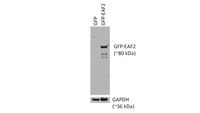EAF2 and p53 Co-Regulate STAT3 Activation in Prostate Cancer
Laura E Pascal 1 , Yao Wang 2 , Mingming Zhong 1 , Dan Wang 1 , Anish Bhaswanth Chakka 3 , Zhenyu Yang 4 , Feng Li 5 , Qiong Song 6 , Lora H Rigatti 7 , Srilakshmi Chaparala 3 , Uma Chandran 3 , Anil V Parwani 8 , Zhou Wang
Neoplasia
20(4)
351-363
2018
Afficher le résumé
The tumor suppressor genes EAF2 and p53 are frequently dysregulated in prostate cancers. Recently, we reported that concurrent p53 nuclear staining and EAF2 downregulation were associated with high Gleason score. Combined loss of EAF2 and p53 in a murine model induced prostate tumors, and concurrent knockdown of EAF2 and p53 in prostate cancer cells enhanced proliferation and migration, further suggesting that EAF2 and p53 could functionally interact in the suppression of prostate tumorigenesis. Here, RNA-seq analyses identified differentially regulated genes in response to concurrent knockdown of p53 and EAF2. Several of these genes were associated with the STAT3 signaling pathway, and this was verified by significantly increased p-STAT3 immunostaining in the Eaf2-/-p53-/- mouse prostate. STAT3 knockdown abrogated the stimulation of C4-2 cell proliferation by concurrent knockdown of EAF2 and p53. Furthermore, immunostaining of p-STAT3 was increased in human prostate cancer specimens with EAF2 downregulation and/or p53 nuclear staining. Our findings suggest that simultaneous inactivation of EAF2 and p53 can act to activate STAT3 and drive prostate tumorigenesis. | 29518696
 |
Regulation of tumor suppressor EAF2 polyubiquitination by ELL1 and SIAH2 in prostate cancer cells
Xinpei Yu 1 2 3 4 , Junkui Ai 1 , Liquan Cai 1 , Yifeng Jing 1 5 , Dan Wang 1 , Jun Dong 1 , Laura E Pascal 1 , Jian Zhang 6 , Rongcheng Luo 3 , Zhou Wang
Oncotarget
7(20)
29245-54
2015
Afficher le résumé
RNA Polymerase II Elongation Factor (ELL)-associated factor 2 (EAF2) is a tumor suppressor frequently down-regulated in human prostate cancer. We previously reported that its binding partner ELL1 can enhance EAF2 protein stability and activity. Here we show that EAF2 can be polyubiquitinated and its degradation blocked by proteasome inhibitor. Co-immunoprecipitation detected EAF2 binding to SIAH2, an E3 ligase, and SIAH2 overexpression enhanced polyubiquitination of EAF2. Co-transfection of EAF2 binding partner ELL1 blocked EAF2 ubiquitination, providing a mechanism for EAF2 stabilization. Finally, EAF2K81R mutant, which exhibits reduced polyubiquitination and increased stability, was more potent than wild-type EAF2 in apoptosis induction. These findings suggest that SIAH2 is an E3 ligase for EAF2 polyubiquitination and ELL1 can enhance EAF2 level and function by blocking its polyubiquitination. | 27058417
 |
FOXA1 modulates EAF2 regulation of AR transcriptional activity, cell proliferation, and migration in prostate cancer cells
Wenhuan Guo 1 , Anne L Keener, Yifeng Jing, Liquan Cai, Junkui Ai, Jian Zhang, A L Fisher, Guohui Fu, Zhou Wang
Prostate
75(9)
976-87
2015
Afficher le résumé
Background: ELL-associated factor 2 (EAF2) is an androgen-regulated tumor suppressor in the prostate. However, the mechanisms underlying tumor suppressive function of EAF2 are still largely unknown. Identification of factors capable of modulating EAF2 function will help elucidate the mechanisms underlying EAF2 tumor suppressive function. <br />Methods: Using eaf-1(the ortholog of EAF2) mutant C. elegans model, RNAi screen was used to identify factors on the basis of their knockdown to synergistically enhance the reduced fertility phenotype of the eaf-1 mutant C. elegans. In human cells, the interaction of EAF2 with FOXA1 and the effect of EAF2 on the FOXA1 protein levels were determined by co-immunoprecipitation and protein stability assay. The effect of EAF2 and/or FOXA1 knockdown on the expression of AR-target genes was determined by real-time RT-PCR and luciferase reporter assays. The effect of EAF2 and/or FOXA1 knockdown on LNCaP human prostate cancer cell proliferation and migration was tested using BrdU assay and transwell migration assay. <br />Results: RNAi screen identified pha-4, the C. elegans ortholog of mammalian FOXA1, on the basis of its knockdown to synergistically enhance the reduced fertility phenotype of the eaf-1 mutant C. elegans causing sterility. EAF2 co-immunoprecipitated with FOXA1. EAF2 knockdown enhanced endogenous FOXA1 protein level, whereas transfected GFP-EAF2 down-regulated the FOXA1 protein. Also, EAF2 knockdown enhanced the expression of AR-target genes, cell proliferation, and migration in LNCaP cells. However, FOXA1 knockdown inhibited the effect of EAF2 knockdown on AR-target gene expression, cell proliferation, and migration in LNCaP cells, suggesting that FOXA1 can modulate EAF2 regulation of AR transcriptional activation, cell proliferation, and migration. <br />Conclusions: These findings suggest that regulation of the AR signaling pathway, cell proliferation, and migration through FOXA1 represents an important mechanism of EAF2 suppression of prostate carcinogenesis. | 25808853
 |














trichlorosilane[842016_(Chloropropyl)trichlorosilane-ALL].jpg)



